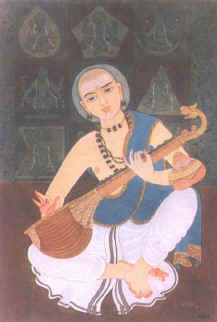|
kSEtra k.rtis
of muttusvAmi dIkSitar (A PILGRIMAGE OF SOUTH INDIA)P. P. NARAYANASWAMI |
|
|
[Editor's Notes: 1) This article has links to audio files, all of which are in Real Audio (32 kbps, streaming stereo) format. To play these, you will need the Real One player, available for free download, from Real Networks 2) The audio clippings included in this article, are strictly for informational and illustrative purposes only 3) Click here for the standard transliteration scheme]
Introduction
Of the Musical Trinity, muttusvAmi dIkSitar was the youngest
and was widely traveled. He was a
zealous pilgrim with an insatiable thirst for visiting sacred places and
singing the glory of the deities present in those holy shrines. He visited a good number of kSEtras (Hindu
temples), and his compositions on temple deities range widely in geographical areas from the southern tip of India
in rAmEshvaram to the far north in kAthmandu.
Since tiruvArUr was the main centre of his activities, we naturally find
a large number of his k.rtis dedicated to the various gods and goddesses in and
around the vicinity of the mammoth tyAgarAja temple there.
The available number of krtis by
dIkSitar varies from 217 (Sangita Sampradaya Pradarshini of subbarAma dIkSitar)
to a maximum of 479 (Vina Sundaram Iyer’s “muttisvAmi dIkSitar kIrtanaigaL” –
the red book in Tamil). Taking this
maximum number of 479, the following is a break down of deities praised in
these k.rtis: shiva
(including kAlabhairava,
vIrabhadra) 131 (27.34%) dEvi
(pArvati,
mInAkshi, rENukA dEvi)
169 (35.28%) lakSmi
9
(1.87%) sarasvati
13 (2.71%) viSNu (excluding rAma, k.rSNa) 41 (8.55%) rAma
20 (4.17%) k.rSNa
14 (2.92%) gaNapati
27 (5.63%) subrahmaNya
36 (7.51%) navagraha
9 (1.87%) hanUmAn
5 (1.05%) brahma
1 (0.21%) shAstA
1 (0.21%) sandhyA
dEvi 1 (0.21%) ga.nga
dEvi
1 (0.21%) mAya
(in
contempt of – not praising)
1 (0.21%) This
list includes three compositions on dual deities – pArvati and parameshvara,
sha.nkara and nArAyaNa, and rAma and k.rSNa (counted only once in the above
listing). These k.rtis can be further classified
under several headings:
Among these 479 k.rtis, 160 are of a
general nature, with no reference to any specific temples. This includes the bulk of 40 k.rtis in sha.nkarAbharaNam, known as noTTu svara sAhityams (western melody).
and all the five compositions on hanUmAn.
The remaining 319 k.rtis are on about 70 temple locations covering
around 150 deities. (dIkSitar might
have visited all these temples, but we are unable to conclude whether he
visited northern India a second time after his return from kAshi to compose k.rtis
on pashupathinAtha (kASmIr), vishAlAkSi (kAshi) etc. With his razor-sharp
memory, he might have composed on these gods/goddesses while staying in south
India.). Also, the exact temple
locations in many k.rtis are difficult to figure out, either:
The Appendix at the end of this write-up
lists all these 70 temple locations with the names of the deities featured in
dIkSitar compositions. The real value of dIkSitar’s k.rtis
lies in the fact that his compositions describe various aspects of
archeological, iconographical and spiritual heritage of South India. His k.rtis, which are the essence of kSEtra mAhAtmya (glorification of
temples) contain architectural details of the temples he visited. Legends surrounding the temples appear side
by side with the musical grammar of the particular rAga in which the
composition is set. His work can be
described as an epitome of the spiritual record of South India. Among the Musical Trinity, tyAgarAja sang
mostly in praise of Lord rAma (the hero of the epic poem rAmAyaNa), and shyAma
sAstri chose to sing on goddess kAmAkSi of kA~ncIpuram, whereas dIkSitar, an advaitin (a believer in non-dualistic system
of philosophy) a tAntrik scholar, and
a j~nAni (possessed of supreme divine
knowledge), composed k.rtis glorifying
almost every God and Goddess in the
Hindu mythology. Most often, his
sAhityas (text of the composition) contain a detailed picture of the shrine,
the idol, the purANic (mythological) associations of the place, the sthala
v.rkSa (the sacred tree associated with the place), the holy tank in the temple
courtyard, some special offerings to the deity, the associated temple festivals, or even the particular form of
its worship. He has to his credit,. many compositions that are suited for every
occasion, for pilgrims to sing at any shrine, on any form of the personal God.
For those who had the doSa (impact, or evil effects) of the stars, he gave the
popular navagraha k.rtis on the nine
planets. There are a variety of
k.rtis for use on festival
occasions, at special annual worship,
and on occasions to mark special vows taken to please Lord gaNesha, goddess varalakSmi, sarasvati, and so on. As a saint, he could be easily regarded
as a 64th nAyanAr for the shaivaite
school of thought, and the 13th ALvAr for the vaiSnavaite system. While
the nAyanArs sang exclusively on shiva, and the AlvArs sang only in praise of
viSNu, it is remarkable that dIkSitar made no exception, and sang on every God
of the Hindu pantheon. |
|
|
Questions or comments? Send
us E-mail. |
|


